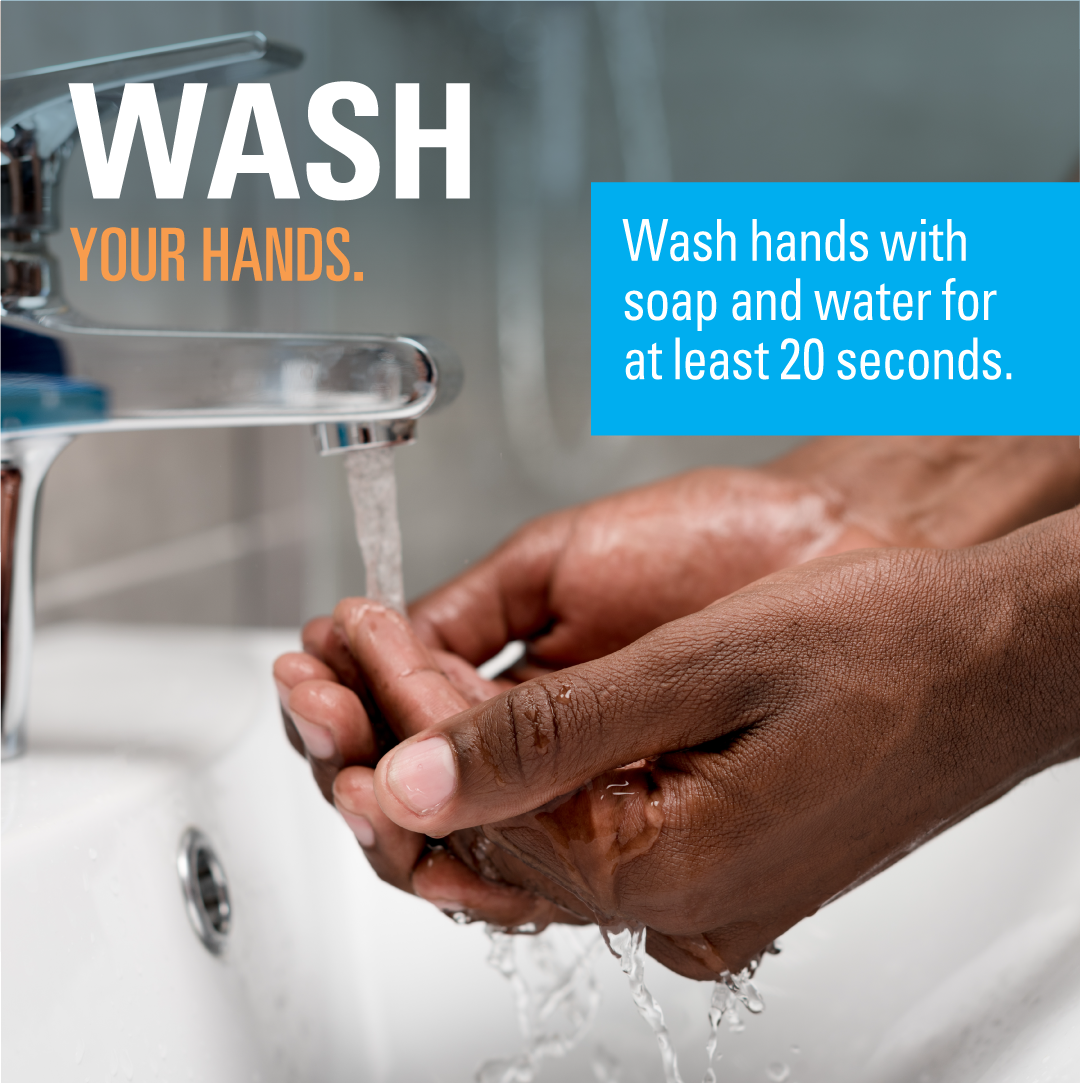
The 3 Ws of COVID-19
Protecting yourself against COVID-19 is similar to how you protect yourself against other illnesses - like the flu or the common cold. But there are a few additional steps you should take.
WEAR
WEAR a face covering or mask when in public, around high-risk people, when caring for others, or when around those not in your household.

What else can you do to stay healthy?
- Avoid touching your eyes, nose and mouth with unwashed hands or while in public places - like grocery or department stores.
- Cover your mouth and nose when you cough and sneeze. Remember, into a cloth, tissue or your elbow, not your hands!
- Throw away tissues after each use.
- Clean and disinfect any high-traffic or dirty surfaces often. Don't forget doorknobs or doorbells that others may have touched.
- Monitor your symptoms and stay on top of your health. A good habit to get into for your total health.
- Avoid being in close contact with people who are sick.

Did you know...a cough or sneeze from COVID-19 can travel up to 27 feet?1 That's why it's important to put a barrier between you and others while in public. Social distancing is a great measure, but wearing a well-fitting mask adds extra protection.
The CDC recommends wearing an N95, KN95 or other close fitting mask to help prevent the spread of COVID-19. Wearing a mask in public places reduces not only your risk for getting COVID-19, but it also protects others around you – like high-risk people, essential workers and older adults.
Wearing a mask while taking other steps to protect yourself – like hand washing and social distancing – is the easiest way to stay healthy during the COVID-19 pandemic.
*This information is adapted from the CDC. Learn more at CDC.gov.
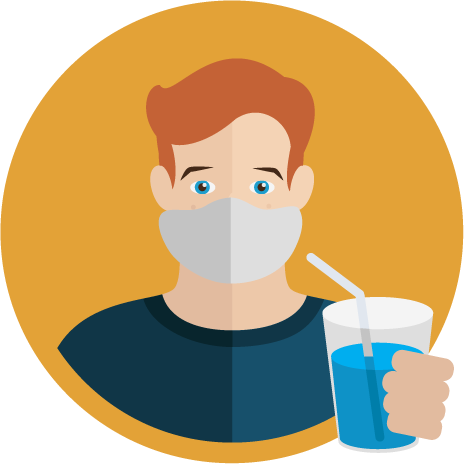
Remember to stay hydrated! Wearing a mask all day can make it easy to forget to drink water. Try setting some time each hour to take a few sips.
Dos
- Wash your hands before and after removing your face covering
- Wear a face covering that fits your face well
- Wash your face coverings at the end of each day
- Avoid touching your face covering while wearing it
- Store your face covering in a secure place - like in a plastic or reusable bag - when you're not wearing it
Don'ts
- Use surgical masks or respirators used for essential health care workers
- Throw used face coverings on the ground or in public places
- Don't use damaged or ripped face coverings
- Wear a loose or ill-fitting face coverings
- Wear your face covering when driving alone, in a park or outside where you are socially distant, or while doing stenuous activity that may impair breathing
Proper ways to wear a cloth face covering
It's important to make sure you're wearing your face covering correctly. There are a few things to remember when putting on your face covering. And remember, face coverings work best when we are ALL wearing them.
- Make sure your face covering covers your nose and mouth
- Face coverings should fit your face
- Don't wear a covering that gaps around your nose, mouth or cheeks
- Don't wear your face covering around your chin or hanging from your ears
- Don't remove your face covering when talking to others
- Don't move your face covering off of your nose or mouth while in public places or unable to social distance
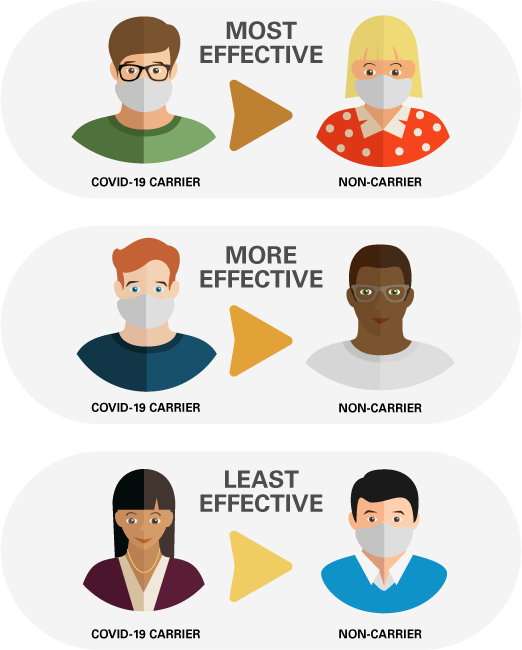

Wearing a cloth face covering gives you protection from COVID-19, but like the airbags in your car, it’s not enough on its own to keep you completely healthy. That’s why it’s important to follow the other steps when combating the spread of the virus.
Think of social distancing like your COVID-19 seatbelt. It’s a great way to put an extra level of protection between you and others who could be sick.
COVID-19 spreads easiest among people who are in close contact - within 6 feet - with each other for a long time. It spreads when someone sneezes, coughs, or talks2. The virus can be spread into the air and into the mouths and noses of others around them – gross, right?
Waiting at least 6 feet away from those around you in public or enclosed spaces is the easiest way to make sure you’re far enough away from these virus droplets. And it’s even more important for those who are high risk.
Tips for social distancing
When you have to run errands, need to get outside for exercise, or just want to take a break from being at home, there are ways you can do it while still social distancing. Here are a few tips:
- Plan your trip before you go! Make sure you know any guidelines that a location or business has
- Only visit stores in-person for essentials like groceries, household items, medications, etc. Try curbside pickup, local delivery, or ship to home options for non-essentials
- If you are shopping in store, look for floor markings or guides to help you stay distant while performing more normal tasks
- Get outside! It's easier and safer to social distance outdoors. Running, hiking, a day at the park or going for a neighborhood walk is a great way to get away from home while being distant from others
- Know your own space. Sometimes we can get caught up in an activity and accidentally get to close to others, it happens. But now more than ever, it's important to know how close you are to others
What if you can't be distant?
If you are an essential worker, public health worker, or just can't be socially distant because of other reasons, it's important to make sure you're following other steps to stay healthy.
- Wash your hands often and whenever caring for others
- Wear a face covering at all times when in public
- Avoid contact with others who could be high-risk
- Follow guidelines by your company, business or state
How to be social while social distancing
We get it. It can be hard to stay inside or away from those you love for long periods of time. But there are ways you can be social while still being socially distant. Try some of these fun and distant activities with your friends or family.
- Virtual cooking classes or competitions
- Virtual coffee chats
- At home concerts or movie series
- Online video or board game tournaments
- Zoom-call family dinners
- Daily walks or national park hikes
- Neighborhood sidewalk chalk decorating
- Start a book club
- Virtual yoga or exercise sessions
- Home or city scavenger hunts
So, you have to stay 6 feet apart to be socially distant. But what exactly is 6 feet? Think of 6 feet like these common things:
A full-size refrigerator
Average height of a white rhino
A three cushion sofa
Almost as tall as Michael Jordan
Width of a sedan
A yoga mat
Two shopping carts (good for those times others are little too close in the grocery store!)

Did you know, only 5% of people wash their hands properly3? That means, when you touch something others have touched, you're transferring all those germs to your belongings or even your face. Gross!
Hand washing, now more than ever, is important for keeping viruses, illnesses and COVID-19 at bay and staying healthy. And washing your hands is still the number one way to reduce the spread of COVID-19 in your community. If you cannot be socially distant or wear a mask, washing your hands is the best defense you have against this virus and spreading it to others.
If you can't wash your hands right away, hand sanitizer is a great alternative. But look for hand sanitizer that has at least 60% alcohol4. Those are the most effective at eliminating dangerous bacteria. Try carrying a hand sanitizer with you at all times or an emergency hand washing kit for those times you can't find soap and water.
*infographic used from the CDC website. You can see the full information here.
Tip: Make sure you're washing your hands for at least 20 seconds to meet CDC recommendations.
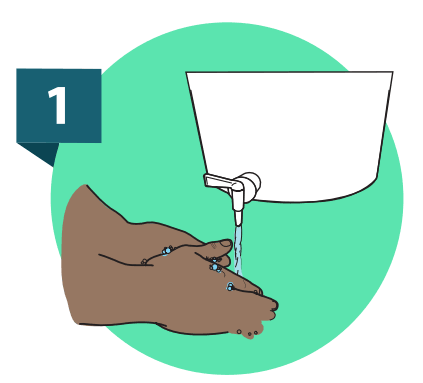
1. Wet hands with water.
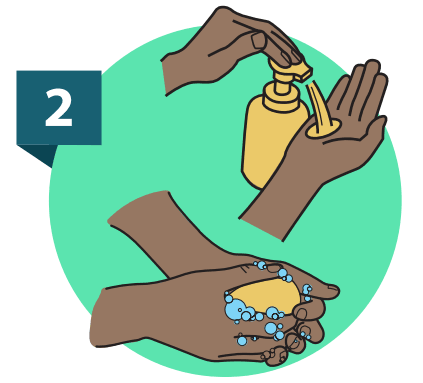
2. Apply enough soap to cover all hand surfaces.

3. Rub hands together and scrub everywhere.
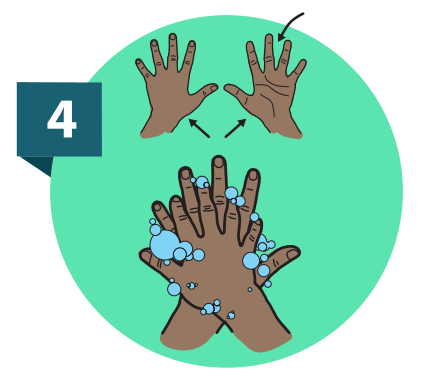
4. Wash the front and back of your hands, in between your fingers, and under your nails.
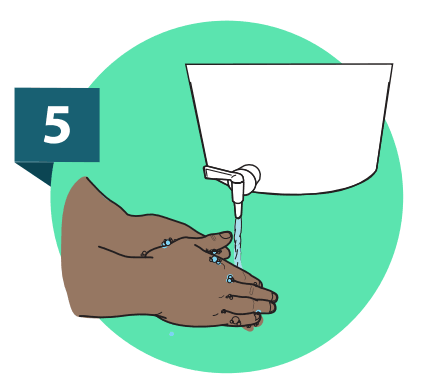
5. Rinse hands with water.
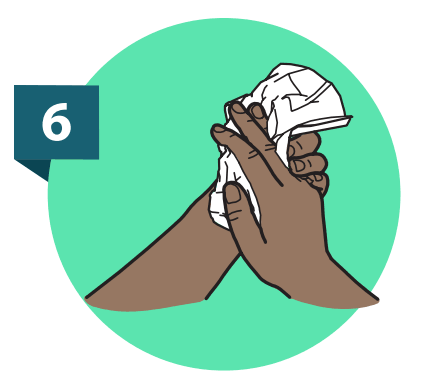
6. Dry hands completely using a single-use towel or air dry.
When should you wash your hands?
- After blowing your nose, coughing or sneezing
- After touching your eyes, nose or mouth when in public
- After being in a public place
- Before and after caring for someone
- Before and after touching or removing your face covering
- After using the bathroom
- Before and after eating food
- After touching doorknobs and handles, buttons or public spaces
The CDC recommends washing hands for at least 20 seconds to ensure you're removing all the germs from your hands. To make sure you're washing for the minimum amount of time, try humming these 20-second songs or verses to make the time go by.
The Happy Birthday song
Sing it twice.
Chorus of "Stayin' Alive" by the Bee Gees
Make sure to belt out the last Stayin' Alive to hit the 20 second mark
Chorus of "Sweet Caroline" by Neil Diamond
But remember no touching hands during COVID-19
Chorus of "Hit Me Baby One More Time" by Britney Spears
For those who want to bring it back to the 90s
Chorus of "I Will Survive" by Gloria Gaynor
Hey, hey those germs won't survive!
"Twinkle, Twinkle Little Star"
Especially good for keeping kids on task while hand washing


 Blue Connect
Blue Connect